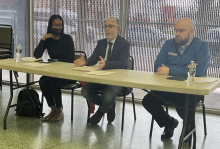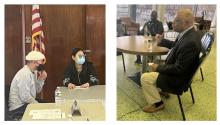
April 5, 2022
This afternoon, Representative Elizabeth Fiedler hosted a policy committee hearing on the topic of Toxic Schools. The hearing took place at the Seafarers Union Hall in Rep. Fiedler's 184th District.
PFT environmental scientist Jerry Roseman presented testimony on the ongoing facilities crisis. He joined Dr. Akira Drake Rodriguez, Assistant Professor, University of Pennslyvania Weitzman School of Design; Iggy Fletcher, Instructor, ATEI IBEW Local 98; and Edy Lai, 9th grader at Furness High School.
Prepared testimony can be accessed here.
Read a thread from the hearing right here.
During the hearing, Roseman offered an assessment of the current crisis and the path forward.
In describing the crisis, Roseman contextualized the crisis, describing just some of what the crisis encompasses:
- Older buildings and systems with “legacy” hazards like lead containing paint, asbestos insulation and other materials and drinking water with elevated levels of lead.
- Buildings with deteriorated and deficient HVAC, roofing and “building envelop” systems that exhibit problems associated with water and moisture intrusion, leaking, and lack of adequate heating, cooling and ventilation. These situations predictably result in mold growth, damage to walls, ceilings, and floors.
- In the situation where an infectious disease hazard like Covid is wreaking so much havoc, poorly or non-functioning HVAC systems, are especially dangerous.
- Buildings where plumbing problems with both drinking water and sanitary system water is deficient. Many drinking water outlets are contaminated by elevated levels of lead, and, as we saw recently at South Philadelphia High School (SPHS), contaminated drinking water, and polluted sanitary system components, can pose health hazards and make a school unsafe.
- In fact, during a recent inspection at the FS Key ES, the location we were originally scheduled to be in for this meeting, I documented only 2 available bathrooms for student use, both located in the basement of a 4 story building with 400 ES students. This is an unsanitary situation, violates codes and good health practices, and negatively impacts educational programming as well. However, it has been, and still is, in place today.
- Schools with infestations of rodents and insects, and a lack of cleanliness with live rodent sightings every day, mouse droppings on books, toys and chairs, and only 50%, or less, of the necessary cleaning staff required to maintain even the most minimal conditions, available. These conditions, especially when combined with eating in classrooms, represent serious asthma triggers that, when present in combination with moisture, dampness, mold and poor air quality heightens the inadequacyof school conditions.
Roseman offered guidance for moving foward including a statewide facility condition assessment approach; development of systems and approaches to ensure effective and comprehensive daa colletion; development of a Comprehensive Educational Facilities Master Plans with meaningful and substantive engagement across stakeholder groups.
Dr. Akira Drake Rodriguez offered three critical steps forward in her testimony:
- The first step is the need for the state to build out technical assistance and legislation to assist districts in spending time-limited ARP/ESSER federal funds for improving school facilities, by removing inadequate and obsolete ventilation systems and water sources/pipes/feeders that harm our public school communities.
- The second step is the need for the state to fully fund and reduce the administrative and fiscal burden on high poverty/high need school districts through the PLANCON program, in accordance with the recommendations from the 2018 report, “Public School Building Construction and Reconstruction Advisory Committee.”
- The third step is for the state to conduct a full census of school facilities conditions and mandate a facilities master plan with engaged and ongoing stakeholder involvement for every school district to receive any state education funds.
Iggy Fletcher of Local 98 noted that as a contractor, he is covered by OSHA--but public sector workers, and students, are not. Looking at the photo of mold in a classroom, he said he would have walked off the job if exposed; but students and educators are allowed to learn and work in those conditions.
Fletcher went on to discuss the possiblity of using solar energy. There are great environmental impacts, and it creates good union jobs.
Furness student Edy Lai closed out the hearing and noted that she feels disappointed. Toxins like lead and asbestos can cause cancer, and in her school, pipes are covered up instead of being replaced. Ceilings are leaking. Conditions are simply unacceptable.
Jerry Jordan reflected on the hearing and asked, "How many Augusts do our students and staff have to be in hot schools? We know we can do something now." Jordan echoed Dr. Drake Rodriguez's rremarks that we can and must do something now. It’s possible!


